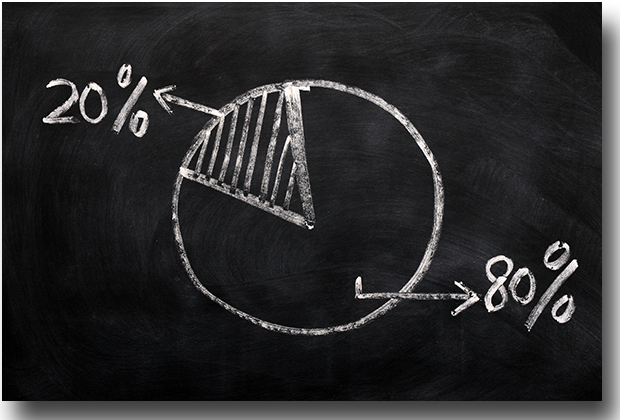Inbound marketing and marketing automation is about doing more for less and the follows the same principle discovered by Pareto. Vilfredo Pareto uncovered a powerful secret hidden in economic statistics: Cause and effect are not in balance. A minority of causes – usually around 20 percent – produces 80 percent of results. The pattern he discerned, now known as “the Pareto Law,” occurs in every area of business: A fifth of your customers accounts for four-fifths of your “dollar sales value.” And a few superstar employees, say 20 percent, are responsible for the majority of your firm’s productivity and value. The “80/20 Principle” proves pervasive outside of business, as well. Twenty percent of drivers are responsible for 80 percent of car accidents. And 20 percent of criminals commit 80 percent of crimes.
So you should take advantage of this principle to improve your company’s marketing but your business performance and your personal effectiveness and happiness. Focus on your most-productive actions and multiply their effects, rather than wasting time and money on unproductive activities. You’ll create more value with less effort.
What are the patterns of the 80/20 rule?
To exploit the 80/20 Principle fully, identify your most-productive actions and resources by using. two complementary techniques: “80/20 Analysis” and “80/20 Thinking.” Make an 80/20 Analysis by gathering data that enable you to measure your ratio of input to output more precisely. Compile sales statistics on various product groups or chart certain customers’ spending. Most likely, you’ll find that specific groups of customers and products produce more than their share of value. Act on these findings two ways:
- Magnify the contributions of the 20 percent – Focus your sales efforts on the most profitable 20 percent of your products. Or, strive to keep your top 20 percent of customers happy instead of diluting your efforts by treating all your customers equally.
- Improve the less valuable 80 percent – Cut costs or raise prices on underperforming products. Introduce products with wider appeal or target sales to underserved customer groups. For instance, women account for most of the sales in shopping malls. Reach more men by installing stores targeted to them. Trying to improve the lagging 80 percent is more difficult, less efficient and generally provides smaller returns than concentrating on the 20 percent.
How do you use it to your advantage?
Use the 80/20 Principle to improve your firm’s profitability. First, compile an accurate picture of where your company is making and losing money. Inspecting overall sales averages won’t help. Instead, compare the profitability of individual product lines or, even better, the profitability of your company’s “competitive segments” – the portions of your business that face different competitors. In most firms, 20 percent of these segments will bring in 80 percent of the profits. The other 80 percent will consist of less-profitable segments and possibly some losers.
Make the most-profitable segments your top priority. Redeploy management and sales staff from lower-performing areas to the 20 percent segments. Strive to sell more to your existing customers in that segment and to attract new customers. Because your margins are high in this area, you may boost your competitive position by cutting prices or offering more services.
Now to nurture your best customers
Apply the 80/20 Principle to your customer relations. You earn most of your profits by selling to a small group of your top customers, so focus your efforts on them. Figure out how to sell them more. Lavish so much attention on them that they become customers for life. These four steps help you “lock in” your best customers:
1. Find your top 20 percent consumers – Before you can give something extra to your best clients or “channels of distribution,” you have to identify them.
2. Provide “outrageous service” – Don’t just meet their needs; exceed their expectations and astonish them. You can’t afford to give this kind of TLC to all your customers, so reserve it for your best.
3. Innovate for your best customers – The most efficient way to gain market share is to sell more to current customers. Anticipate their needs, and design new products and services specifically for them. Involve them in product development.
4. Win their loyalty – Long-term customers drive profitability. Efforts to keep them may increase costs in the short term, but will boost long-term profits.
Business & Finance Articles on Business 2 Community
(378)
Report Post







